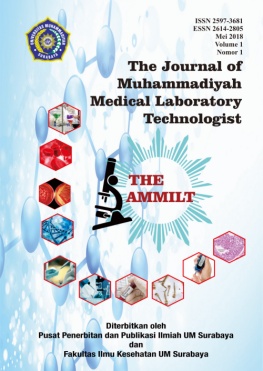Isi Artikel Utama
Abstrak
Â
abstract
 (Averrhoa bilimbi) is one of the plants that can be used as an antibacterial, good flowers, stems, leaves and stems have benefits and efficacy. Chemical constituents of the leaves starfruit are tannins, flavonoids, saponins. The active ingredient in the leaves starfruit is tannin. Escherichia coli is a bacterium that causes diarrhea. From the above discussion, the authors raised the theme of Influence starfruit juice of the leaves on the growth of pathogenic E. coli bacteria.
Formulation of the problem researchers is whether there is influence starfruit juice of the leaves on the growth of Escherichia coli pathogens. This study aims to determine the concentration that could inhibit and kill Esherichia coli Escherichia coli. This research is experimental. The sample used is leaf green starfruit not so young in a fresh state taken in the area around the boarding author Sutorejo 11B stay. In this study, the sample size for each treatment as much as 3 100%, 90%, 80%, 70%, 60%, 50%, 40%, 30%, 20%, 10% and C (control). Independent variables are starfruit juice of the leaves, while the dependent variable growth of Escherichia coli. When the study carried out in January and July 2012. Data on the effect of starfruit juice of the leaves on the growth of Escherichia coli tested by laboratory examination and data collection techniques using Chi-Square 0:05. Based on the results it appears that at a concentration of 100% and 90% were able to kill the bacteria Escherichia coli, whereas the inhibitory power ranging from a concentration of 80%, 70%, 60%, 50%, 40%, 30%, 20%, 10%. From Chi-Square test was obtained λ2 count <of λ2 table. From this it turns out there leaves starfruit juice effect on the growth of Escherichia coli pathogenic bacteria.
Keyword : Leaves starfruit, E. Coli
Rincian Artikel
Referensi
- Anonim, 2010. Belimbing wuluh Kaya Khasiat. http://alamendah.wordpress.com/2010/08/15/belimbing-wuluh-averrhoa-bilimbi-kaya-khasiat/. 08 Januari 2012
- Anonim. 2011. Pengertian Perasan. http://deskripsi.com/p/peras. 23 Februari 2012
- Anonim. 1996. Pengertian Ekstrak. http://deskripsi.com/p/ekstrak. 23 Februari 2012
- Anonim. 2012. Pengertian Rebusan. http://deskripsi.com/r/rebusan. 23 Februari 2012
- Anonim. 2012. Pertumbuhan Bakteri. http://biologipedia. com/2010/12/pertumbuhan-bakteri.html. 15 Maret 2012
- Anonim. 2011. Koloni E.coli di Media. http://randstarteam.com/2007_12_01_archive.html. Diakses 17 Maret 2012
- Amnur. 2008. Cikal Bakal Averhoa Bilimbi. http://Averhoabilimi.blogspot.com. 10 Januari 2012
- Cahyadi, Wisnu. 2008. Analisis Aspek Kesehatan Bahan Tambahan Pangan. Edisi 2. Jakarta. Bumi aksara.
- Dasuki. 1991. Sistematika Tumbuhan Tinggi. Pusat Universitas Ilmu Hayati ITB. Bandung
- Darmadi, Agus. 2011. Bakteri E.coli. http://timpal-timpalcom./2011/06/bakteri-E.coli-sumber-energi-masa-depan.html. 10 Maret 2012
- Hayati. Elok. 2011. Dibalik Mukjizat Tanaman Belimbing wuluh (Averrhoa bilimbi l) sebagai Pengawet Alami. http://elokkamilah.wordpress.com. 08 Januari 2012
- Jawetz, dkk. 1996. Mikrobiologi Kedokteran. Edisi 20. Jakarta. EGC
- Naim. 2004. Mekanisme Kerja Tanin. http://kerjatanin.wordpress.com. 23 Februari 2012
- Naim, Nilla. 2011. Escherichia coli. http://www.nillaaprilianaim/Escherichia-coli.htm. 17 Maret 2012
- Pratiwi, T. 2008. Mikrobiologi Farmasi. Bandung. Erlangga
- Sudjana. 1996. Metode Statistika. Edisi 6. Tarsito Bandung
- Ummah, Khoirul. 2010. Ekstraksi dan Pengujian Aktivitas Antibakteri Senyawa Tanin Pada Daun Belimbing wuluh (Averrhoa bilimbi l). http://lib.uin-malang.ac.id/thesis/fullchapter/05530001-masithah-khairul-u.ps. 19 Maret 2012
Referensi
Anonim, 2010. Belimbing wuluh Kaya Khasiat. http://alamendah.wordpress.com/2010/08/15/belimbing-wuluh-averrhoa-bilimbi-kaya-khasiat/. 08 Januari 2012
Anonim. 2011. Pengertian Perasan. http://deskripsi.com/p/peras. 23 Februari 2012
Anonim. 1996. Pengertian Ekstrak. http://deskripsi.com/p/ekstrak. 23 Februari 2012
Anonim. 2012. Pengertian Rebusan. http://deskripsi.com/r/rebusan. 23 Februari 2012
Anonim. 2012. Pertumbuhan Bakteri. http://biologipedia. com/2010/12/pertumbuhan-bakteri.html. 15 Maret 2012
Anonim. 2011. Koloni E.coli di Media. http://randstarteam.com/2007_12_01_archive.html. Diakses 17 Maret 2012
Amnur. 2008. Cikal Bakal Averhoa Bilimbi. http://Averhoabilimi.blogspot.com. 10 Januari 2012
Cahyadi, Wisnu. 2008. Analisis Aspek Kesehatan Bahan Tambahan Pangan. Edisi 2. Jakarta. Bumi aksara.
Dasuki. 1991. Sistematika Tumbuhan Tinggi. Pusat Universitas Ilmu Hayati ITB. Bandung
Darmadi, Agus. 2011. Bakteri E.coli. http://timpal-timpalcom./2011/06/bakteri-E.coli-sumber-energi-masa-depan.html. 10 Maret 2012
Hayati. Elok. 2011. Dibalik Mukjizat Tanaman Belimbing wuluh (Averrhoa bilimbi l) sebagai Pengawet Alami. http://elokkamilah.wordpress.com. 08 Januari 2012
Jawetz, dkk. 1996. Mikrobiologi Kedokteran. Edisi 20. Jakarta. EGC
Naim. 2004. Mekanisme Kerja Tanin. http://kerjatanin.wordpress.com. 23 Februari 2012
Naim, Nilla. 2011. Escherichia coli. http://www.nillaaprilianaim/Escherichia-coli.htm. 17 Maret 2012
Pratiwi, T. 2008. Mikrobiologi Farmasi. Bandung. Erlangga
Sudjana. 1996. Metode Statistika. Edisi 6. Tarsito Bandung
Ummah, Khoirul. 2010. Ekstraksi dan Pengujian Aktivitas Antibakteri Senyawa Tanin Pada Daun Belimbing wuluh (Averrhoa bilimbi l). http://lib.uin-malang.ac.id/thesis/fullchapter/05530001-masithah-khairul-u.ps. 19 Maret 2012

